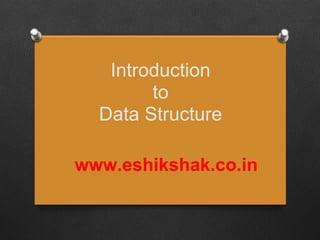Signaler
Partager
Télécharger pour lire hors ligne

Recommandé
Recommandé
Contenu connexe
Similaire à Introduction of data_structure
Similaire à Introduction of data_structure (20)
Algorithm 110801105245-phpapp01-120223065724-phpapp02

Algorithm 110801105245-phpapp01-120223065724-phpapp02
Algorithms-Flowcharts-Data-Types-and-Pseudocodes.pptx

Algorithms-Flowcharts-Data-Types-and-Pseudocodes.pptx
Architecting and productionising data science applications at scale

Architecting and productionising data science applications at scale
Plus de eShikshak
Plus de eShikshak (20)
Mesics lecture 7 iteration and repetitive executions

Mesics lecture 7 iteration and repetitive executions
Mesics lecture 6 control statement = if -else if__else

Mesics lecture 6 control statement = if -else if__else
Dernier
Mehran University Newsletter is a Quarterly Publication from Public Relations OfficeMehran University Newsletter Vol-X, Issue-I, 2024

Mehran University Newsletter Vol-X, Issue-I, 2024Mehran University of Engineering & Technology, Jamshoro
Dernier (20)
This PowerPoint helps students to consider the concept of infinity.

This PowerPoint helps students to consider the concept of infinity.
Unit-V; Pricing (Pharma Marketing Management).pptx

Unit-V; Pricing (Pharma Marketing Management).pptx
Kodo Millet PPT made by Ghanshyam bairwa college of Agriculture kumher bhara...

Kodo Millet PPT made by Ghanshyam bairwa college of Agriculture kumher bhara...
Food safety_Challenges food safety laboratories_.pdf

Food safety_Challenges food safety laboratories_.pdf
Russian Escort Service in Delhi 11k Hotel Foreigner Russian Call Girls in Delhi

Russian Escort Service in Delhi 11k Hotel Foreigner Russian Call Girls in Delhi
ICT role in 21st century education and it's challenges.

ICT role in 21st century education and it's challenges.
Introduction of data_structure
- 1. Introduction to Data Structure www.eshikshak.co.in
- 2. Algorithm ● An algorithm is a finite set of instructions which, when followed, accomplishes a particular task. ● Its Characteristics ○ Each instruction should be unique and concise ○ Each instruction should be relative in nature and should not be repeated infinitely. ○ Repetition of same task(s) should be avoided. ○ The result be available to the user after the algorithm terminates. www.eshikshak.co.in
- 3. Efficiency of Algorithms ● The performance of algorithms can be measured on the scales ● Time ● Space www.eshikshak.co.in
- 4. Space Complexity ● The amount of memory space required by the algorithm during the course of execution ● Some of the reasons for space complexity are ○ If the program, is to run on mutli-user system, it may be required to specify the amount of memory to be allocated to the program ○ We may be interested to know in advance that whether sufficient memory is available to run the program. ○ There may be several possible solutions with different space requirements. www.eshikshak.co.in
- 5. Space needed by Program Components ● Instruction Space – Space needed to store the executable version of the program and it is fixed. ● Data Space : It is needed to store all constants, varialbe values ● Environment Space : Space needed to store the information needed to resume the suspended functions. www.eshikshak.co.in
- 6. Time Complexity ● The amount of time needed to run to completion. ● Some reasons for studying time complexity ○ We may be interested to know in advance that whether a program will provide satisfactory real time response. ○ There must be several possible solutions with different time requirements. www.eshikshak.co.in
- 7. Data structure ● When elements of data are organized together in terms of some relationships among the elements, the organization is called data structure. ● A data structure is a set of data values along with the relationship between the data values in form of set of operations permitted on them. ● Arrays, records, stacks, lists, graphs are the names of some of some of these basic data structures. www.eshikshak.co.in
- 8. A data structure can be (a) transient i.e. it is created when a program starts and is destroyed when the program ends. Most data structures in main memory are transient, for example, an array of data. (b) Permanent i.e. it already exists when a program starts and is preserved when the program ends. Most data structures on disk are permanent, for example, a file of data, or a cross- linked data file collection (a database). www.eshikshak.co.in
- 9. Data Structure Linear Non-Linear ● Array ● Tree ● Stack ● Graph ● Queue ● Linked Lists www.eshikshak.co.in
- 10. Abstract Data Type (ADT) ● It is a mathematical model with a collections of operations defined on that model. ● The ADT encapsulates a data type can be localized and are not visible to the users of the ADT. ● An implementation of an ADT is a translation into statements of a programming language, of the declaration that defines a variable to be of that ADT, plus a procedure in that language for each operation of the ADT. www.eshikshak.co.in
